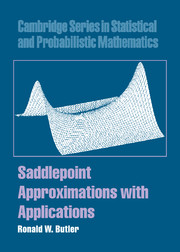Book contents
- Frontmatter
- Contents
- Preface
- 1 Fundamental approximations
- 2 Properties and derivations
- 3 Multivariate densities
- 4 Conditional densities and distribution functions
- 5 Exponential families and tilted distributions
- 6 Further exponential family examples and theory
- 7 Probability computation with p*
- 8 Probabilities with r*-type approximations
- 9 Nuisance parameters
- 10 Sequential saddlepoint applications
- 11 Applications to multivariate testing
- 12 Ratios and roots of estimating equations
- 13 First passage and time to event distributions
- 14 Bootstrapping in the transform domain
- 15 Bayesian applications
- 16 Nonnormal bases
- References
- Index
12 - Ratios and roots of estimating equations
Published online by Cambridge University Press: 25 February 2010
- Frontmatter
- Contents
- Preface
- 1 Fundamental approximations
- 2 Properties and derivations
- 3 Multivariate densities
- 4 Conditional densities and distribution functions
- 5 Exponential families and tilted distributions
- 6 Further exponential family examples and theory
- 7 Probability computation with p*
- 8 Probabilities with r*-type approximations
- 9 Nuisance parameters
- 10 Sequential saddlepoint applications
- 11 Applications to multivariate testing
- 12 Ratios and roots of estimating equations
- 13 First passage and time to event distributions
- 14 Bootstrapping in the transform domain
- 15 Bayesian applications
- 16 Nonnormal bases
- References
- Index
Summary
The ratio R = U/V of two random variables U and V, perhaps dependent, admits to saddlepoint approximation through the joint MGF of (U, V). If V > 0 with probability one, then the Lugannani and Rice approximation may be easily applied to approximate the associated CDF. Saddlepoint density approximation based on the joint MGF uses the Geary (1944) representation for its density. This approach was first noted in Daniels (1954, –9) and is discussed in section 12.1 below.
The ratio R is the root of the estimating equation U − RV = 0 and the distribution theory for ratios can be generalized to consider distributions for roots of general estimating equations. The results of section 12.1 are subsumed into the more general discussion of section 12.2 that provides approximate distributions for roots of general estimating equations. Saddlepoint approximations for these roots began in the robustness literature where M-estimates are the roots of certain estimating equations and the interestwas in determining their distributions when sample sizes are small. Hampel (1973), Field and Hampel (1982), and Field (1982) were instrumental in developing this general approach.
Saddlepoint approximation for a vector of ratios, such as for example (R1, R2, R3) = {U1/V, U2/V, U3/V}, is presented in section 12.3 and generalizes the results of Geary (1944). An important class of such examples to be considered includes vector ratios of quadratic forms in normal variables. A particularly prominent example in times series which is treated in detail concerns approximation to the joint distribution for the sequence of lag correlations comprising the serial autocorrelation function.
- Type
- Chapter
- Information
- Saddlepoint Approximations with Applications , pp. 374 - 429Publisher: Cambridge University PressPrint publication year: 2007

